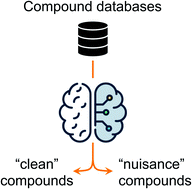Nuisance small molecules under a machine-learning lens
Abstract
Small molecules remain a centrepiece in molecular medicine. Specific drug target recognition is an unavoidable requirement for their successful translation to the clinic. While testing chemical matter for affinity and potency is the mainstay, only more recently have the chemical biology and medicinal chemistry communities become more profoundly aware of potential attrition and development pitfalls linked to artifactual readouts. Auto-fluorescence, assay interference and colloidal aggregation are the most common sources of false positive hits in screening assays and may divert drug development pipelines toward unfruitful research avenues. In this Perspective, I dissect how computational tools, in particular machine-learning pipelines, can accelerate the development of chemical probes and drug leads by expediting the identification of liable chemical matter. Further, I conceptualize anomaly detection for chemical biology and highlight limitations to a more productive deployment of machine learning. By solving pressing challenges, one might gradually mitigate the impact of nuisance compounds in drug discovery.



 Please wait while we load your content...
Please wait while we load your content...